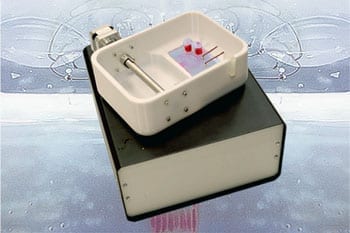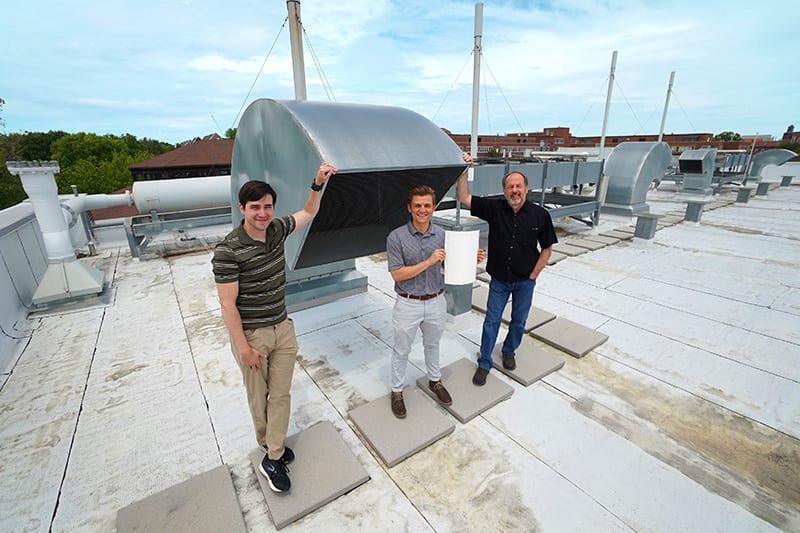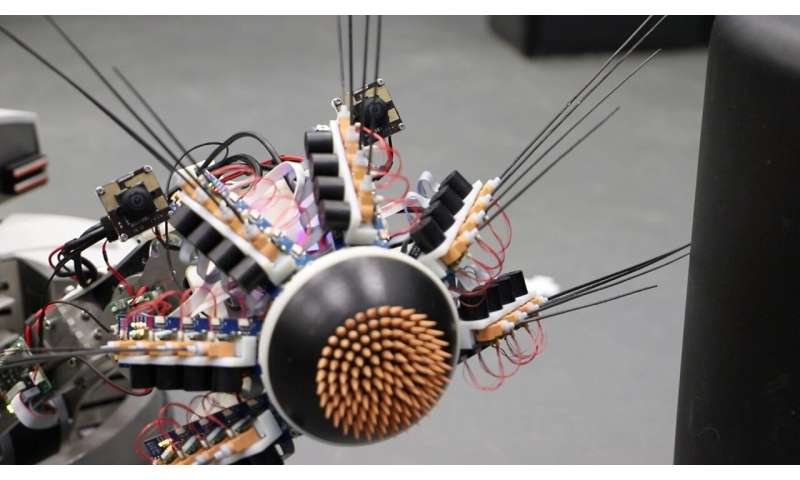
A fully printable biosensor made of soft bio-inks interfaces with a pig heart. Research about the biosensor, developed by researchers at Purdue University and Los Alamos National Laboratory, has been published in Nature Communications. (Photo Credit: Bongjoong Kim)
Surgeons may soon be able to localize critical regions in tissues and organs during a surgical operation thanks to a new, patent-pending Purdue University biosensor that can be printed in 3D using an automated printing system.
Chi Hwan Lee created the biosensor, which allows for simultaneous recording and imaging of tissues and organs during a surgical operation. Lee is the Leslie A. Geddes Assistant Professor of Biomedical Engineering in the Weldon School of Biomedical Engineering and assistant professor of mechanical engineering. Lee also has a courtesy appointment in materials engineering.
“Simultaneous recording and imaging could be useful during heart surgery in localizing critical regions and guiding surgical interventions such as a procedure for restoring normal heart rhythms,” Lee said.
Traditional methods to simultaneously record and image tissues and organs have proven difficult because other sensors used for recording typically interrupt the imaging process.
“To this end, we have developed an ultra-soft, thin and stretchable biosensor that is capable of seamlessly interfacing with the curvilinear surface of organs; for example the heart, even under large mechanical deformations, for example cardiac cycles,” Lee said. “This unique feature enables the simultaneous recording and imaging, which allows us to accurately indicate the origin of disease conditions: in this example, real-time observations on the propagation of myocardial infarction in 3D.”
By using soft bio-inks during the rapid prototyping of a custom-fit design, biosensors fit a variety of sizes and shapes of an organ. The bio-inks are softer than tissue, stretch without experiencing sensor degradation and have reliable natural adhesion to the wet surface of organs without needing additional adhesives. Kwan-Soo Lee’s research group in Los Alamos National Laboratory is responsible for the formulation and synthesis of the bio-inks.
A number of prototype biosensors using different shapes, sizes and configurations have been produced. Craig Goergen, the Leslie A. Geddes Associate Professor of Biomedical Engineering in Purdue’s Weldon School of Biomedical Engineering, and his laboratory group have tested the prototypes in mice and pigs in vivo.
“Professor Goergen and his team were successfully able to identify the exact location of myocardial infarctions over time using the prototype biosensors,” Lee said. “In addition to these tests, they also evaluated the biocompatibility and anti-biofouling properties of the biosensors, as well as the effects of the biosensors on cardiac function. They have shown no significant adverse effects.”
Research about the biosensor has been published in the peer-reviewed Nature Communications.
Original Article: Printable Purdue biosensor simultaneously records, makes images of tissues and organs
More from: Purdue University | Los Alamos National Laboratory
The Latest Updates from Bing News & Google News
Go deeper with Bing News on:
3D printed biosensor
- Best 3D printers for 2024
However, finding the right 3D printer for your needs and skill level can be difficult, especially with so many different models and designs available. If you figure out what it is you want to ...
- FFF 3D Printing: Can New Nozzle Technology Replace Resin Printers?
Do you need a resin 3D printer when FFF devices now approach similar levels of surface quality? That sounds like a crazy question. For many years it’s been 3D print gospel that resin equipment ...
- 3D Printing in Biomedical Sensing Technology
By Taha Khan May 2 2024 Reviewed by Lexie Corner Three-dimensional (3D) printing is a type of additive manufacturing that constructs three-dimensional objects layer by layer from a digital model. This ...
- Researchers hack 3D printer to make it ‘laser print’ polymers
3D printing or additive manufacturing allows ... wearable electronics and biosensors,” said Anna Herland, a professor in Micro and Nanosystems at KTH. During the initial tests, the team made ...
- 3D Printed Aerospike Was Designed By AI
We’re still in the early days of generatively-designed objects, but when combined with the capabilities of 3D printing, we’re already seeing some interesting results. One example is this new ...
Go deeper with Google Headlines on:
3D printed biosensor
[google_news title=”” keyword=”3D printed biosensor” num_posts=”5″ blurb_length=”0″ show_thumb=”left”]
Go deeper with Bing News on:
Simultaneous recording and imaging biosensor
- Panasonic announces firmware update for LUMIX S5II and S5IIX cameras
The Proxy Video Recording feature enables simultaneous recording of low bit-rate proxy files during video capture. This enhancement aims to streamline data transfer, editing, and post-production ...
- Selena Gomez Latest News, Photos, and Videos
Freya Skye just dropped her first new song as a Hollywood Records recording artist! The singer and actress signed the first ever simultaneous record and television deals with Disney earlier this ...
- First Listen Latest News, Photos, and Videos
Freya Skye just dropped her first new song as a Hollywood Records recording artist! The singer and actress signed the first ever simultaneous record and television deals with Disney earlier this ...
- Long-Term Continuous Electrocardiographic Recording
Long-term AECG recording is indicated for patients suspected of Prinzmetal's variant angina, in whom the simultaneous recording of ST-segment elevation with symptoms should confirm the diagnosis (Fig.
- Canon XA75 review: a niche camcorder for pros
When I set up the dual SD card slots for simultaneous recording of MP4 and XF-AVC formats – with two SanDisk Extreme Pro cards – there weren't any noticeable delays in recording or writing ...
Go deeper with Google Headlines on:
Simultaneous recording and imaging biosensor
[google_news title=”” keyword=”simultaneous recording and imaging biosensor” num_posts=”5″ blurb_length=”0″ show_thumb=”left”]










